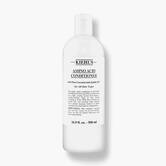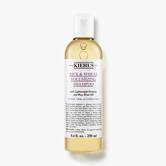Thick, luscious hair is a goal many of us aspire to. But what if your hair is naturally on the opposite side of the spectrum? Fine, thin hair is common in both women and men alike. And, sometimes, it can seem like an uphill battle for people with thin hair to plump up the look of their locks. Plus, if you do get your thin hair looking a little more robust, the challenge then becomes trying to keep it that way. Fortunately, we are here to help.
Certain hairstyles and an effective fine haircare routine can help give it a thicker appearance. Read on to learn more about the potential causes of fine, thin hair and our top tips for a healthier-looking mane.
Why Is My Hair Thinning?
Most people lose between 50 to 100 hairs each day, but if you’re noticing your hair thin, your shedding likely exceeds that. There can be quite a few reasons behind why you are experiencing fine, thin hair. It’s important to consult with an expert and identify what may be causing thinning hair, which may also help reveal what you can do to help give your hair a thick appearance. Some catalysts for thin hair are internal, like genetics. Others are external, such as an improper fine haircare routine. See if any of the below sound like they may apply to you. While it’s harder to thwart the biology behind thin hair, there are environmental factors that may be within your control.
Age
As you age, your hair ages with you. With each passing year, the rate of your hair growth slows, and your natural hair color becomes less vibrant. Eventually, more and more hair follicles stop growing hair altogether. The result: thin hair.
Heredity
The most common cause of hair loss around the world is genetic, otherwise known as male or female pattern hair loss. It means that you’ve inherited genes from one or both of your parents that are programmed to eventually shrink your hair follicles and cause some of them to cease growing hair. In women, this looks like your hair is thinning all over your scalp—a telltale sign is a widening part. While in men, hair loss most often begins with a receding hairline or sparseness on the top of your head.
Stress
Stressful events in your life may also contribute to thin, fine hair. These include things like childbirth, illness, or medical interventions. Thin hair may also be the result of other stressful situations such as divorce, the death of a loved one, or a particularly taxing job or academic program.
Poor nutrition
Your hair needs certain nutrients—and the right balance of them—to keep it healthy. Not getting enough biotin, iron, protein, or zinc, for example, can starve your hair, as can eating too few calories. On the flip side, getting too much of some nutrients can have the opposite effect. Taking supplements is a common way some people try to combat fine hair, but overdoing it with certain nutrients, including vitamin A and selenium, may contribute to hair thinning.
Medication
Certain medications can have the unfortunate side effect of hair loss. Try taking note of when you began to see your hair thinning. If it lines up with when you started a new medication, talk to your doctor.
Aggressive haircare and styling
If you regularly color, perm, or relax your hair, or have a love affair with your hot tools, your hair may be sustaining a substantial amount of damage, leading to hair loss. Similarly, certain hairstyles can tug on your hair, like high ponytails or tight braids. These can hasten the onset of fine, thin hair.
Friction
In the same vein, friction is a known cause of breakage. And it can hide in seemingly innocuous places. A cotton pillowcase, for instance, can grab strands while you sleep. As can a cotton towel if you dry your hair too vigorously with it. Instead, try switching to a silk pillowcase and drying your hair with something softer, like a microfiber towel or soft T-shirt.
Our Tips to Help Those With Thin Hair
As with most things in life, some things you can take charge of, and others are out of your hands. If you think your thin hair may result from aggressive heat or chemical processing, for example, tweaking your haircare routine may help address the problem. Ahead, we’ll clue you in on our top haircare tips for addressing fragile strands at home. (Of course, if you’re really concerned about your thin, fine hair, it may be time to speak with your dermatologist to help you on your way.)
Shampoo Less
One way to help reduce hair loss is to shampoo less often. Thin, fine hair is delicate, making it a prime target for damage. How often you wash your hair can vary from person to person, but washing it too frequently can make your hair drier, more brittle, and, hence, more prone to shedding and breakage. So go easy on your hair with a gentle shampoo and conditioning system.
Amino Acid Shampoo
Try Amino Acid Shampoo, which offers a gentle formula with amino acids, fairly-traded coconut oil, and hydrolyzed protein. It is designed to be used on all hair types and helps boost body and fullness. Use it with Amino Acid Conditioner, which is also formulated with amino acids, coconut oil, and hydrolyzed protein plus jojoba oil. It helps strengthen your hair and maintain its natural moisture balance for a shiner, healthier-looking mane.
Use a Scalp Scrub
Products, natural oil, dead skin cells, and impurities can build up on your scalp between washes. Scrubs like our new Amino Acid Scalp-Detoxifying Treatment Scrub, formulated with 10 amino acids, sea salt, and salicylic acid, can help. It gently exfoliates the skin on your scalp while dissolving dead skin cells, impurities, buildup, and pollution. When used consistently, it helps create an optimal scalp environment for strong, healthy-feeling strands to grow. Swap it out with your shampoo once a week for a fresher-feeling scalp and stronger, fuller-looking hair.
Be Kinder to Your Hair
As mentioned, coloring, perming, or relaxing your hair, as well as hot tools, can wage an assault on fragile strands. Try forgoing or limiting chemical hair treatments and heat-styling for a while to see if it helps. This includes air-drying your hair, rather than using a blow dryer, and wearing looser hairstyles. Also, try not to play with your hair too much, like twisting it around your finger, which could pull at the hair. Ditto when it comes to grooming. Brush your hair gently or use a wide-toothed comb to help reduce the amount of tension on it.
How Can I Make My Hair Appear Thicker?
If you’re wondering how to get thicker-looking hair, you may want to consider a haircare routine designed for fine hair.
Rice & Wheat Volumizing Shampoo
Choose your products carefully. Look for ones designed specifically for fine, thin hair or damaged locks. We recommend Rice & Wheat Volumizing Shampoo and Conditioner, which contains (you guessed it) hydrolyzed wheat and rice proteins, as well as honey. Formulated for flat, thin, or fine hair, this dynamic duo joins forces to revitalize thinning, lifeless strands while boosting volume and body. It smooths split ends and flyaways and coats hair with a volumizing complex for a thicker, healthier appearance.
How Do You Keep Fine Hair Healthy?
As with all good things, hair growth takes time. While you move away from hair-thinning behaviors and into an effective fine haircare routine, try some of the below tips to help achieve and maintain healthy-looking hair.
Don’t wash with hot water
Turn down the temperature dial when you bathe. A hot shower may feel heavenly, but it can wreak havoc on your mane (and skin) by stripping it of its natural oils. Remember: dry hair is fragile hair, so use warm water instead.
Use reparative formulas
The key to healthy-looking hair is keeping it strong and well-nourished. Damage Repairing & Rehydrating Shampoo and Conditioner can help do just that. The system, with moringa tree oil—a beauty oil used since Ancient Egypt—hyaluronic acid, and ceramides, is uniquely formulated for very dry and damaged hair. It gently cleanses while helping to repair and replenish weak, brittle hair, leaving it visibly more lustrous, shiny, and healthy-looking. It won’t weigh your hair down and will smooth and nourish even the most fragile strands.
Don’t skip conditioner
Be sure to use conditioner every time you shampoo. Not only can it help improve the look and feel of your hair, but with the right formula, it may help strengthen your strands, too.
Don’t apply conditioner to your scalp
Conditioner really shouldn’t be applied to your scalp, as this can weigh your hair down and make your hair greasy. It can also quicken buildup on your scalp that inhibits your roots. Instead, focus on the areas that need it the most: your length and the ends of your hair.
Fortify your strands with a serum
Finally, give your hair some more love with a targeted serum. Silk Groom Serum, formulated with vitamin E and sunflower and sesame oils, tames frizz and dry ends for hair that’s soft, shiny, and silky-smooth. It won’t weigh your strands down and has the added benefit of protecting your hair from humidity. Perfect for the warmer months.








